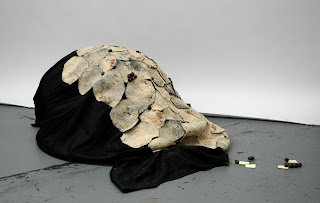Project Overview
This project is an introduction to the work of sculptor, Nick Cave, and his Soundsuit series. This is a big project. You will have two in-class work days to complete it. Time-management is very important!
For this project, make a wearable sculpture that covers your whole body. Look at the artist Nick Cave's Soundsuits for inspiration, but make the idea your own. Think about a way to incorporate sound into your project.
For this project you may use all of the skills and materials you have learned about through the year: cardboard, sewing, carving, paper, natural materials, found objects, and assemblage.
Think about how you will move your body to create sound. How can you transform yourself with the suit?
Note: You will be wearing your project during your jury, so make sure it is comfortable and that you can see. Also, be sure to consider transportation. Can it be made in sections?
For this project, make a wearable sculpture that covers your whole body. Look at the artist Nick Cave's Soundsuits for inspiration, but make the idea your own. Think about a way to incorporate sound into your project.
For this project you may use all of the skills and materials you have learned about through the year: cardboard, sewing, carving, paper, natural materials, found objects, and assemblage.
Think about how you will move your body to create sound. How can you transform yourself with the suit?
Note: You will be wearing your project during your jury, so make sure it is comfortable and that you can see. Also, be sure to consider transportation. Can it be made in sections?
Schedule
Homework for May 4th: Look at lots of pictures, videos, and articles about Nick Cave's Soundsuits. Get to know them really well. Make sketches for your wearable sculpture, and bring materials that you want to work with to class. You should bring A LOT of materials to class.
April 4: Studio Day- Grade based on bringing in your materials and detailed sketches.
April 4: Studio Day- Grade based on bringing in your materials and detailed sketches.
May 11: Studio Day- Grade based on having basic structure complete (wearable).
Project Due: Wearing it for your jury. Final project grade will be determined at Jury.
Rubric
This project will count for two full grades. One for the actual finished project (which will be presented and graded during Juries). The overall quality of your work will be assessed on: creativity, aesthetics (form, composition, color, unity/cohesiveness, use of materials), construction technique (how things are attached, how it connects to your body), and the quality/quantity of the sound it creates.The second grade will be based on your time-management, and effort (being prepared & working in class).



























































